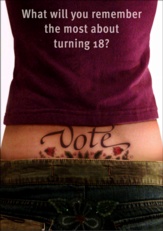
tattoo -
A form of body art in which
a needle is pushed into the skin and a pigment
injected. This is a somewhat painful procedure leaving an image
which, although blurring over time, is
otherwise permanent.
Because tattooing techniques have
the potential to spread diseases, sanitary conditions are extremely
important.
The word itself comes from the Polynesian markings known as tatu or tatau, which were first described by Captain James Cook in his 1769 voyage to the South Pacific. Since then tattoos of distant cultures have been seen as reflections of ritual and kinship, permanent markers of status and role.
The significance and status of the tattoo in European and American history are different. Its roots can be seen in ancient Greek and Roman cultures, and, as you'll see below, in ancient Russia. In one path of Western tradition, it was a brand of criminality, a sign of shame that goes back to the biblical account of Cain. The branding of slaves has been common in numerous cultures. A second path in the West has come with the Christian association of tattoos with stigmata — signs of Jesus' wounds — tattoos becoming popular souvenirs among Christian pilgrims from the Middle Ages onwards. The branding of criminals evolved into a declaration of pride with prison tattooing, and the world community of seamen treated the tattoo as a trademark.
Although tattoos continue to harbor hints of shame — a dark sign created at society's margins, having associations with carnival displays of fully tattooed men and women — tattoos have been emerging from the shadows in the last twenty years to have a renaissance. Even as it becomes a more mainstreamed activity, tattooing is rebelling nevertheless. Like piercing, tattooing reverberates with latent tribal overtones, allowing teens and their elders to convey a street-tough look. Many designs are proclamations of untameable power: the dragon, the eagle, the lion, the Harley-Davidson motorcycle. Tattoo images also invoke forms of social connection. The tattoo asserts a bond of shared experience, marked by a rose, a rainbow, a heart, a Sacred Heart of Jesus, Celtic knots. The tattoo encompasses both ambitions. It is an attempt to fix one's identity permanently as a social being while declaring one's autonomy from social demands.
Examples:

Russia, Altai, Pazyryk Burial Mound 2, Tattooed Body of a Tribal Chief, 5th
century BCE,
human skin, Hermitage Museum, St. Petersburg, Russia. The body
of a chief, found in his burial mound, was tattooed almost all
over, preserved enough for us to be able to see some of his tattoos.
The right arm from the wrist to the shoulder bears representations
of six fabulous animals, their hindquarters twisted around, and
with branching horns. The right leg from the kneecap to the ankle
is covered with the representation of a fish. On the chest is
a tiger with a spiralling tail. On the left arm are two stags
and a leaping moufflon with its hind legs bent under.

Japan, Tattooed Couple, 20th century. This is
a photograph of the backs of the heavily tattooed bodies of a
husband and wife whose skin has been tattooed with the images
of their tutelary dieties: she has in effect become Kannon and
he, Fudo -- and these two gods, Compassion and Anger, stand arm-in-arm.
Stevie
Moon (American, 1968-) tattooist, Sacred Heart on
Niall's chest, 1999. Stevie Moon works in Ft. Lauderdale, FL,
Miami, FL, and Boston, MA.

Richard Prince (American, 1949-) photographer,
Untitled,
1996-99, Ektacolor print, 27 1/4 x 20 7/8 inches, edition of
5. See appropriation,
gaze, and photography.
Luis J. Jimenez, photographer for The New York Times, Marlon Enrique Fuentes, deported by the U.S. and jailed in Honduras, displays his Los Angeles gang ties with facial tattoos: "XVIII" on his forehead, "Cry Me" and "Try Me" on his cheeks. Published with the article by Ginger Thompson, "TATTOOED WARRIORS: Shuttling Between Nations, Latino Gangs Confound the Law," September 26, 2004. Ms Thompson reported that, "over the last decade gangs have spread like a scourge across Central America, Mexico, and the United States, setting off a catastrophic crime wave. . . ." Tattoos have been popular among gang members, sometimes serving to display gang ties. Ms Thompson reported that gang members have been going through painful, expensive, and scarring procedures to have their tattoos removed, because, as one puts it, "If we do not take off these tattoos, we will never be able to live in peace."

Huanwu Zhai (American, contemporary), What will you remember most about turning 18?, 2004, poster. Click on the title to download an 11 x 17 inch PDF file. You'll need Adobe's free Acrobat Reader software to open and read this file. If you don't have it, download it by clicking here. This poster is one of numerous "get out the vote" posters designed by members of AIGA.
Also see art careers and scarification.
https://inform.quest/_art